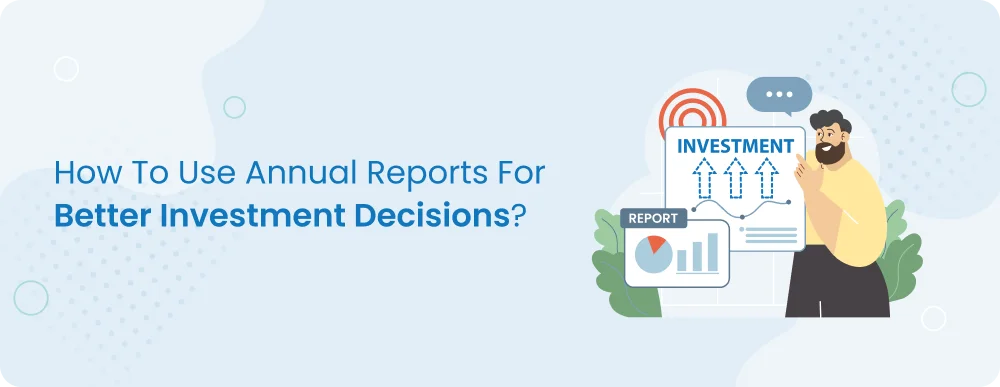How to Use Annual Reports for Better Investment Decisions
Noor Kaur
31 Dec 2024Tags:
Featured
Using annual reports effectively can significantly enhance your investment decisions. These reports offer a wealth of information on a company's financial health, strategy, and future prospects. Focusing on key metrics and insights allows you to make more informed choices that align with your long-term financial goals.
What is an Annual Report?
An annual report is a comprehensive document with a detailed overview of a company’s financial performance and activities over the past year. It includes key information such as financial statements, management analysis, and other insights into the company’s operations, goals, and future outlook.
Key Sections to Focus on in an Annual Report
When reviewing an annual report, several sections stand out when evaluating a company's financial health and making informed investment decisions. These include:
1. The Financial Statements: Understanding the Numbers
The balance sheet, P&L, and cash flow statement provide key information about a company's assets, liabilities, profits, and cash movement. These statements form the foundation for financial analysis and help you assess the company’s financial health.
2. Management Discussion and Analysis
This section offers management’s perspective on the company’s performance, challenges, and plans. Also, it's important for investment analysis, as it reveals how management plans to tackle risks and seize growth opportunities.
3. Auditor’s Report: What It Tells You
The auditor’s report confirms the accuracy and fairness of the financial statements. A clean auditor’s report enhances trust in the financial reports, while a qualified report may indicate concerns.
4. Notes to the Financial Statements
These notes provide detailed explanations behind the numbers in the financial statements. They include information on accounting methods, significant risks, and other factors that could impact future performance, which are crucial for stock market fundamental analysis.
How to Analyse Key Metrics for Investment Decisions
When making stock market and investing decisions, analysing key financial metrics is crucial. These numbers provide insights into a company's performance and future potential, helping you make more informed choices. Here’s how to assess some of the most important metrics:
1. Profitability Ratios
These ratios show how well a company generates profit from its revenues. High profitability ratios indicate a business can effectively convert sales into profits, essential for sustainable growth.
2. Liquidity Ratios
Liquidity ratios assess a company's ability to meet short-term obligations. A higher ratio portrays a stronger ability to pay off its current debts, reducing financial risk.
3. Debt Levels and Leverage
Debt levels and leverage (using borrowed money to finance investments) are important to understand a company’s financial stability. High debt can lead to higher risk, especially during economic downturns.
4. Return on Equity (ROE)
ROE measures how effectively a company uses shareholders' equity to generate profit. A high ROE indicates strong management performance and a good return on investment.
Understanding the Business Model and Strategy
Understanding a company’s business model and strategy is crucial for assessing its long-term potential and alignment with your investment goals. Here’s how to break it down:
- Review the company’s revenue sources and cost structure to understand how it generates profits.
- Analyse its competitive edge and market positioning to gauge sustainability in the long run.
- Look for growth, innovation, or diversification in the company’s strategy.
- Evaluate how management plans to adapt to changes in the market, technology, and consumer demand.
Risk Factors and Their Impact on Investment
Apart from understanding the business model, recognising risk factors that could impact your investment is equally important. Here’s how to spot them:
- Identify financial risks that may affect the company's stability, such as high debt levels or unpredictable cash flow.
- Look for external risks, like regulatory changes or market volatility, which could influence the business’s performance.
- Be aware of operational risks, such as supply chain disruptions or reliance on key personnel, that could hurt profitability.
- Pay attention to strategic risks, such as an overdependence on one product or market, which may limit growth opportunities.
How to Use Annual Reports for Forecasting Future Performance
Annual reports are powerful tools for forecasting a company’s future performance. You can predict how the company might perform in the coming years by examining key sections. Here’s how to use them effectively:
- Focus on profitability ratios to gauge the company’s ability to generate profit over time.
- Look at past trends in financial analysis and reports to identify growth patterns that could continue into the future.
- Evaluate the company’s management and strategies for signs of long-term vision in your investment analysis.
- Use financial analysis to assess the company’s financial health, including debt levels and liquidity, which impact future performance.
- Perform a stock market fundamental analysis to understand how the company’s financial standing could influence stock value in the long term.
- Keep track of the report's forward-looking statements or projections to better understand management's outlook.
Red Flags to Look for in an Annual Report
When reviewing an annual report, it’s important to look for warning signs that could affect your investment decisions. These red flags may indicate potential risks or concerns in the company's financial health. Here's what to watch for:
- Declining profitability: If profitability ratios are falling, it could signal trouble in maintaining consistent earnings.
- Inconsistent revenue growth: A lack of stable revenue growth may point to underlying business issues.
- Excessive debt: High debt levels compared to equity can put the company at risk, especially in challenging economic conditions.
- Weak cash flow: Poor cash flow may indicate problems with liquidity and the company’s ability to meet its financial obligations.
- Unclear financial statements: Complex or vague financial reports may be hiding important details from investors.
- Red flags in management discussions: It could be a warning sign if management downplays risks or avoids direct answers.
The Role of Annual Reports in Long-Term Investment Planning
Annual reports offer crucial insights into a company's financial health, helping you make informed choices. Here's how they can influence your investment planning:
- Annual reports provide an in-depth look at a company’s performance, offering data vital for financial analysis.
- The stock market and investing decisions are heavily influenced by the data in financial reports, especially when assessing profitability and growth.
- Reviewing the investment analysis section helps determine if a company aligns with your long-term investment goals.
- You can gauge a company’s market value, management efficiency, and future potential through a fundamental analysis of the stock market.
- Profitability ratios in the report reveal how well a company converts revenue into profits, which is essential for assessing its financial stability.
Conclusion: Making Informed Investment Decisions with Annual Reports
Incorporating the insights from annual reports into your investment analysis process helps you identify promising opportunities and avoid potential risks. Also, by understanding the financial reports thoroughly, you can make smarter decisions in the stock market and investing, positioning yourself for long-term success.
FAQs
How can I access annual reports for companies not listed on the stock exchange?
You can typically access annual reports for private companies through their official website or by directly requesting them from the company. Some companies also share reports with stakeholders or investors upon request.
Are there any online tools that help analyse annual reports for investment decisions?
Yes, several tools like Morningstar, Yahoo Finance, and S&P Capital IQ offer analysis features and financial data from annual reports, helping you make informed investment decisions.
What should I do if the annual report doesn’t provide enough information on key metrics?
If key metrics are missing, consider looking for alternative sources such as financial reports, earnings calls, or contacting the company directly for more detailed insights.
How can I compare the annual reports of two companies in the same industry?
Focus on key financial ratios like profitability ratios, liquidity ratios, and debt levels. Also, compare revenue growth, profit margins, and other relevant metrics to evaluate the performance and stability of each company.
Do annual reports include forward-looking statements or future projections?
Yes, most annual reports include management's outlook and projections, typically in the "Management Discussion and Analysis" section, which outlines future goals and potential risks.
Are there any red flags in annual reports that might suggest the company is in financial trouble?
Yes, watch for signs like declining profitability ratios, rising debt levels, poor cash flow, or inconsistent revenue. Also, a qualified auditor's report could indicate potential financial issues.
Noor Kaur
31 Dec 2024Related blogs


What is SME IPOs: Meaning, Differences and How to Apply
Small and medium-sized businesses, also known as SMEs, are crucial for socioeconomic growth in many developing cou...


Evaluating Indian Sectors: Key Investment Factors | mastertrust
A few decades ago, individual investors faced the challenge of getting access to sufficient information. However, ...


India's Investment Landscape: A Comprehensive Guide | mastertrust
Investments in India have consistently outperformed those in other emerging nations.


5 secret benefits of investing in mutual fund
Investing in mutual funds is a strategic move. From diversification of funds to long-term growth, the possibilitie...
Sign up to our newsletter !
Share this article on
Recent articles
Tags:
Open a Demat Account in just 15 minutes !

Click on open
account below

Fill out some
basic details

Upload your
documents

Start trading in
24 Hours *
Commonly asked questions
Is Master Capital Services Limited SEBI registered?
Do you have a mobile app for Trading and Finance Management?
What services does mastertrust provide?
What is the minimum investment required to start trading with your company?
Is my personal and financial information secure with your company?
What is your customer support availability?

